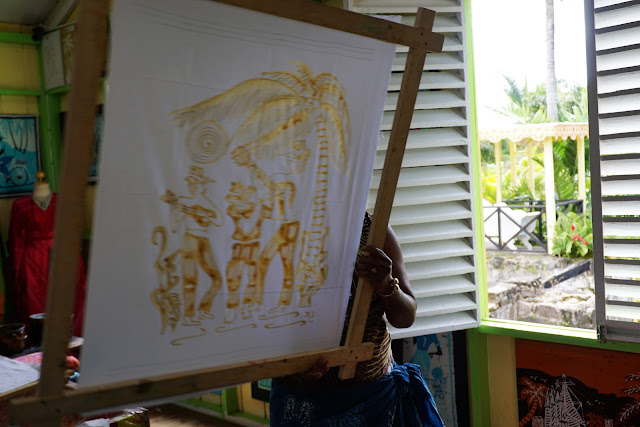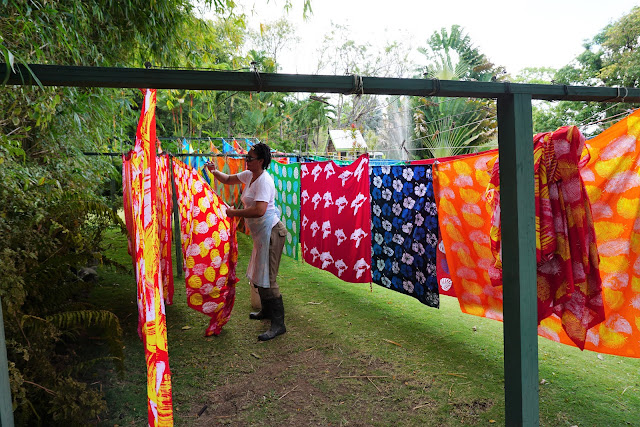St. Kitts is an island with a surprising number of things to see, especially considering that it is only 18 miles long and an average of 5 miles across.
My brother headed off on his own journey to climb Mount Liamuiga, the 3,792-foot-tall volcano that dominates the western end of the island.
 |
| Picture borrowed from here |
The remaining five of us toured Basseterre (see last post), and then headed out of the city in our rental car on a trip along the coast.
Just a note about renting a car. On most of the Eastern Caribbean islands, the steering wheel is on the right and you drive on the left side of the road as you do in Great Britain, the opposite of what we're used to. It can be a little disconcerting at first, but you'll get used to it quickly. However, driving is further complicated on St. Kitts because the roads are almost all only wide enough for one car, so if there is two-way traffic, one car pulls as far over to the left as possible.The roads were clearly not built for a lot of automobiles.
No wonder that in some places, St. Kitts feels like an uninhabited tropical jungle:
Our first stop was one I had requested, a batik factory. I had read that batik is one of the main crafts of the Caribbean, and Romney Manor is the place to go to see it made.
Long before batik became popular here, however, he first European settler of this area was Sam Jefferson, the third-great-grandfather of Thomas Jefferson. He established a home on St. Kitts in the early 17th century, but sold part of his estate to the Earl of Romney in the mid-17th century. Successive Earls of Romney owned this area through the mid-19th century. In 1834, contrary to the wishes of British Parliament, the Lord Romney of the day freed all his slaves, making the Romney Estate the first one in St. Kitts to emancipate its slaves.
Moving forward to the 20th century, since 1974 the Caribelle Batik company has been operating a highly successful business from this spot. The name "Caribelle" can be broken down into its two key parts: "Carib" (for Caribbean) and "belle" (meaning beautiful). And beautiful it is:
In fact, I would put it in the top five most beautiful places we visited on this trip:
The gardens are especially exquisite:
This plant is called hanging lobster claw:
There is an enormous "Saman" tree on the property that is over 400 years old. Indigenous Carib Indians probably brought the tree with them from South America. The trunk has a circumference of 23 feet, and the canopy covers 2/3 of an acre. It is thought to be the largest Saman tree in the Western Hemisphere.
Orchids are growing on its branches:
Until I lived in California, I thought a palm tree was a palm tree. I learned fairly quickly that there are dozens of kinds of palm trees. Outside of California, there are even more palm tree types. These Caribbean palms with their furry fronds, red fruit, and antenna-like spires don't look much like any of the palms I'm used to:
Some parts of the Manor look like a Hollywood movie set:
This bell tower was once used to regulate the lives of the Romney Manor slaves by signaling key transitions during the day. When slaves were emancipated, the first thing they usually did was destroy the hated bell tower. However, the Earl of Romney was not as cruel as other slave owners. When emancipation was declared, the Earl released his slaves immediately, while other slaver holders created a four year apprenticeship to keep their slaves in bondage. As a result, the Romney Manor bell tower was less of a target and is the only perfectly preserved tower still standing on St. Kitts.
On to the reason I was interested in Romney Manor in the first place--batik. Batik cloth and clothing is still produced in a little house on the Romney Manor estate.
Demonstrations show how each batik piece is made by hand:
I recorded part of the demonstration just because I loved listening to this woman speak:
We exited out the back door:
Newly created pieces are hung out to dry on two triple clotheslines in the backyard:
The bright, happy swaths of damp fabric were swaying in the wind like rows of graceful dancers on a stage:
The tree in the photo below is a "strangler fig," so named because seeds lodge and sprout in crevices of the branches. When the shoots grow upwards and the roots grow downward, the new trees envelop and strangle the host tree:
The view through the trees:
We walked from Romney Manor down a well-maintained path to Wingfield Estates, one of the oldest sugar cane plantations on St. Kitts:
Along the trail I saw my first mushrooms in the Caribbean. I would expect to see more in this damp climate, but I saw very few:
The jungle wildlife:
This island used to be a great producer of sugar cane, and the Wingfield plantation existed in part to turn the sugar cane into rum:
I love some of the names of the vegetation:
This one is a "custard apple tree":
Stan? Stan?!! WHAT ARE YOU DOING?
The ruins were quite extensive:
There are some pretty cool underground tunnels:
These vervet monkeys aren't native to St. Kitts, but they've been here for almost 300 years, thanks to the French or British travelers who brought them here. We did see some swinging high up in the trees next to Wingfield Estates, so we were excited to see one up close.
For a small fee (say, half of your retirement account), you could pose with the baby monkey:
READING
 Right before our trip, I read Ron Chernow's biography of Alexander Hamilton. I particularly enjoyed reading about Hamilton's youth in the Caribbean, including time spent on St. Kitts. As we walked around the Romney Manor and Wingfield Estates, I could almost picture what it would have been like to be a child here 270 years ago.
Right before our trip, I read Ron Chernow's biography of Alexander Hamilton. I particularly enjoyed reading about Hamilton's youth in the Caribbean, including time spent on St. Kitts. As we walked around the Romney Manor and Wingfield Estates, I could almost picture what it would have been like to be a child here 270 years ago.Hamilton and his brother were born out of wedlock, and their mother died when Hamilton was only about nine years old. He and his brother were raised by a series of relatives, and it's no wonder that Hamilton decided early on to get away from the islands. I was intrigued by his education--largely a result of his own efforts, particularly his voluminous reading. I think of how hard it would have been to come by books in those days and in that place. He was quite the guy.

























































Those ruins at Wingfield Estate are some of the few ruins that remain of the slave era that was the Caribbean for centuries. Romney Manor certainly was beautiful and the batik is fun.
ReplyDeleteI really liked the Romney Manor. I'm still peeved your monkey cost half of what my money did.
ReplyDelete